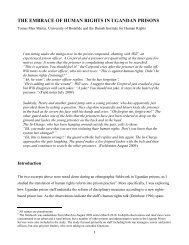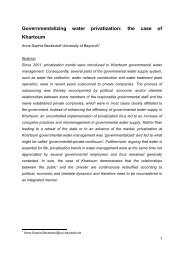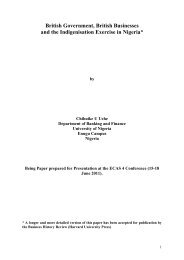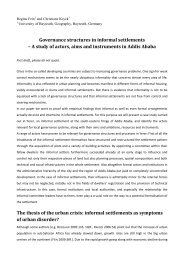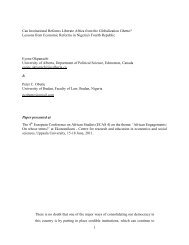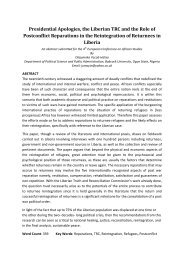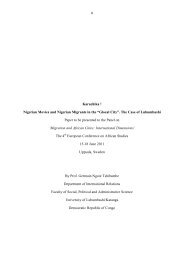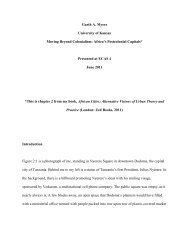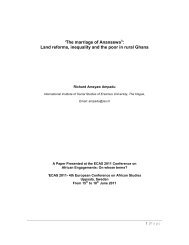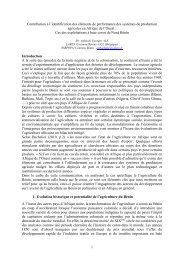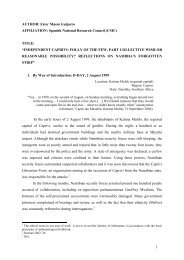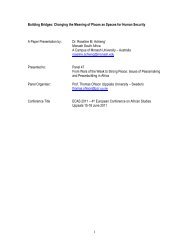Evam Kofi Glover - The Nordic Africa Institute
Evam Kofi Glover - The Nordic Africa Institute
Evam Kofi Glover - The Nordic Africa Institute
You also want an ePaper? Increase the reach of your titles
YUMPU automatically turns print PDFs into web optimized ePapers that Google loves.
JUGGLING STAKES IN THE JUMBLE: THE MAGIC OF MARITAL<br />
DECISION MAKING AMONG YOUNG URBAN ELITE FEMALES IN<br />
Introduction<br />
GHANA<br />
<strong>Evam</strong> <strong>Kofi</strong> <strong>Glover</strong><br />
Two principal and conflicting arguments have been advanced in the literature concerning<br />
the trends of polygyny in <strong>Africa</strong>. On the one hand, there are those who see a decline of<br />
polygyny at least in the more urban environments of <strong>Africa</strong>. Modernization theorists for<br />
example, have largely alluded to the end of polygyny as society develops. Goode‟s<br />
(1963:187) i assertion is a classic reference point. He noted: “Women‟s increasing<br />
freedom of choice and the gradual shift from subsistence agricultural economy to a<br />
market or industrial one has meant a steady decline in polygyny”. It could be inferred that<br />
as females become free in choosing their mates as well as better economic prospects<br />
through formal education and professions outside the home avail for them, monogamy at<br />
the expense of polygyny - at least among elites - becomes the norm. Goode (1963) further<br />
argues; „In <strong>Africa</strong>‟s urban industrial areas, polygyny has become relatively rare: … urban<br />
life confers on the women none of the benefits that polygyny has in tribal areas‟ (p.188).<br />
Confirming this, Caldwell (1967) noted; “the physical family does in fact encounter<br />
many problems in town, especially, physical and economic problems… the fact that<br />
wives are willing to enter into polygynous marriage shows that they are not educated<br />
enough to earn the kind of wages as paid in town for professional or skilled work”<br />
(Caldwell, 1967: p.178). This throws us back to the old supposition that polygyny is a<br />
function of low education and the comparative maladjustment of the female in the<br />
modern economic system in <strong>Africa</strong>. From this perspective, decline in polygyny in the<br />
urban societies of <strong>Africa</strong> is expected as a natural consequence of changing aspirations,<br />
educational status and economic prospects of the female. Such trends are associated with<br />
accepting “the norms and practices governing modern life-styles, and, specifically, those<br />
affecting familial relations, than they would be in a rural context” (Clignet and Sween<br />
1974). ii<br />
1
It could be expected therefore that when elites make decisions about marriage, higher educated<br />
and economically independent females including those in white-collar occupations in the urban<br />
society constituting “… an important and salient reference group and model of modern-life-styles<br />
and behavior for other women” (Dinan 1983) iii would be inclined towards monogamy rather than<br />
polygyny (Omari, 1962; Tetteh, 1967; Caldwell, 1967; Oppong, 1982) iv . <strong>The</strong> most obvious<br />
question that arises from this stance is whether with romantic love leading to monogamy as the<br />
ideology, polygyny has disappeared among educated, professional and economically sound elites<br />
in Ghana.<br />
<strong>The</strong> second school of thought joins the debate at its weakest point. Proponents argue that<br />
polygyny in <strong>Africa</strong>n cities may not be declining as argued but has rather metamorphosed to fit the<br />
demands of the urban environment (Locoh, 1994; Mann, 1994; Karanja, 1987; Obbo, 1987;<br />
Clignet, 1987; Notermans, 2002) v . Making a clear distinction of the phenomenon between rural<br />
and urban environments in <strong>Africa</strong>, Karanja (1994) observes that “…reports, especially from the<br />
urban areas in many countries, indicate that people have opted for a different type of polygyny,<br />
private polygyny, which they perceive as being more in consonance with their perceptions of<br />
modernity”.<br />
At the core of the debate is whether the urban society has traces of polygynous marriages among<br />
the elites; if they do - when, why and how – become legitimate questions. While the debate over<br />
polygyny is echoed time and again in the literature, it is interesting that the process of decision<br />
making that leads to it seems to be glossed over. <strong>The</strong> question remains; when do elites transform<br />
or ignore social borders between monogamy and polygyny? Obviously there is little empirical<br />
work on social processes involved in border crossings between monogamy and social openings<br />
for polygyny among elites. This paper seeks to explore the decision making process of young<br />
urban elite 1 females in Ghana concerning type of marriage with focus on the processes that may<br />
lead to acceptance of polygyny. Specifically, the emphasis is on the complex arrangements,<br />
negotiations, and modifications by human players, within the specific material and cultural<br />
context of the city that determine border crossings between monogamy and polygyny among elite<br />
women.<br />
1<br />
<strong>The</strong> term “elite” refers here and hereafter to highly educated, members of the Ghanaian society: It includes<br />
Administrators, civil servants, professionals, university lecturers and the like.<br />
2
<strong>The</strong> Social Context<br />
<strong>The</strong> concept of urbanism as a way of life has dominated the argument against polygyny and its<br />
anticipated “eradication” especially among the elite. To Little (1974) vi for example, the concept<br />
of „urbanization‟ connotes „the process whereby people acquire material and non-material<br />
elements of culture, behavior patterns and ideas that originate in or are distinctive of the city.‟<br />
Indeed the complex social and economic influences of urbanization that historically manifested<br />
through colonialism, industrialization and globalization have variously been noted to have<br />
affected the family institution in Ghana in diverse ways. <strong>The</strong>se effects are generally expected to<br />
alter familial systems in the direction of monogamous arrangements.<br />
In the context of the city (synonymous with the urban environment) in Ghana, higher education<br />
is significantly the major determinant for potential social mobility. <strong>The</strong> city becomes the symbol<br />
of emancipation and for individual agency in achieving objectives. In this spirit, the challenges<br />
of cultural control in the traditional notion of division of labor between males and females<br />
become fluid. Clark (2003) vii for example regards the city as the space within which the current<br />
realities experienced by younger generations intersect with the historical legacy of modes and<br />
categories of cultural production. In this sense, the city is a melting pot that produces a<br />
hybridized form of space in which the old, new and fluid cultural identities emerge, are<br />
negotiated or contested. <strong>The</strong> fluidity is manifest in the routine daily struggle of members to meet<br />
their diverse aspirations. <strong>The</strong> bottom line is supposedly measured by meritocracy - a system in<br />
which advancement is based on individual ability or achievement and not ascription. On daily<br />
basis therefore the question facing the young person is how she can envision a better life – career<br />
and family life trajectory - across the ambiguous terrain of the city where relations are sometimes<br />
transient and informal and where belonging is sometimes in question.<br />
In this bargain, employers seeking to maximize space in the global market demand human<br />
capital. Both males and females equally yoked, compete within market imperatives that award<br />
performance by technical competence. However, historical and cultural realities for affirmative<br />
action and “equity”, especially for the ill-prepared segment of the population, are largely ignored.<br />
Glaring differential accessibility to resources especially between males and females over the years<br />
is manifest in this struggle where even within the family, some parents prefer to spend resources<br />
3
on male children at the expense of the female. With females lagging far behind and struggling to<br />
keep pace, questions of the relationship between economic capital and women‟s agency, as well<br />
as between varied paths for negotiating and inclusion of cultural identity-reinforcing reactions<br />
become crucial.<br />
Within this context therefore the trajectories of the emancipation and empowerment for females<br />
are yielding new values which spur new social development agenda involving the most profound<br />
interests of females. Certainly, female education, employment opportunities, status and<br />
empowerment are highly desirable objectives that should be pursued in their own right. <strong>The</strong><br />
International Conference on Population and Development (ICPD 1994) viii for example marked a<br />
turning point not only in the globalization of the movement for women‟s empowerment but also<br />
highlighting the sexual health challenges of especially adolescents in the developing world. In this<br />
context, human sexuality and gender relations, the definition of the family, and the inclusion of<br />
adolescents marked the paradigm shift towards the broader reproductive health approach.<br />
<strong>The</strong> declaration of the 1994 ICPD has facilitated series of subsequent activities towards practical<br />
implementations for removing the historical, social, cultural and economic layers of<br />
entanglements. <strong>The</strong>se fire expectations and new significations. <strong>The</strong> obvious first effects are seen<br />
in the role of many Non-Governmental Organizations (NGOs) that have effectively fought and<br />
won the debate over Female Genital Mutilation (FGM), promotion of girl-child education to the<br />
highest level, equal opportunities for both male and female in professional careers and political<br />
roles that were hitherto male dominated. Despite these strides, historical and cultural<br />
underpinnings create a lopsided reality in which females remain the most disadvantaged in efforts<br />
to achieve their aspirations (Caldwell, 1975; Bleek, 1987; Oppong, 2009) ix<br />
To overcome the structural hegemonies that hem them in, females learn to take every opportunity<br />
in creating space for themselves and to develop a large repertoire of approaches for manipulating,<br />
controlling, and creating the social capital needed to achieve individual objectives. <strong>The</strong> individual<br />
in such a context is not without agency. For Peter Leonard (1984) x this social reality provides the<br />
individual with choices and it is these choices that dictate the dialectic between the individual and<br />
social order. Thus, new orders are created as females work their way against the stiff walls<br />
historically created and maintained in the triple roles that until recently served as the boundary<br />
between males and females in the Ghanaian society.<br />
4
Indeed, with education becoming increasingly the main determinant for potential social mobility<br />
in Ghana, more and more females struggle in the competitive environment with their male<br />
counterparts to find placement in the new competitive order. Females are the most vulnerable in<br />
this competition where some parents prefer to support male children for higher education at the<br />
expense of the female. However it is important to indicate that a number of females accept this<br />
discrimination as “natural” and therefore feel helpless about making any efforts even where<br />
opportunity avails. As discussed by Thompson (1997), xi oppression or discrimination of this sort<br />
occurs at three levels: the personal level, the cultural level, and the structural level. Thompson<br />
argues that these three levels of oppression in dynamic interaction with each other reinforce and<br />
influence one another. We can only understand the situation by looking at it in a more holistic<br />
perspective because one‟s thoughts, attitudes, and behavior is a function of what happens in the<br />
larger context with these three levels interacting continuously with each other. With very limited<br />
sources of financial and moral support outside the immediate family therefore some females<br />
“…in town with meager or no resources of her own can avoid poverty by attaching herself to a<br />
well-to-do man” (Karanja 1994). <strong>The</strong> search for resources and young women‟s attempts at<br />
strategic allocation of their reproductive power has been observed to be widespread including<br />
among the highly educated. Karanja pointed out that “Some evidence suggests … women<br />
undergraduates, young professionals, secretaries, and the like are willing to attach themselves to<br />
men of means while they wait for the „right‟ man to come along” (Karanja 1994:201). But<br />
elsewhere Karanja (1987: 257-8) noted that some of these highly educated females cannot wait<br />
indefinitely for that ideal “right man to come along”. <strong>The</strong> ideal is tempered with social realities, a<br />
manifestation of “the potential tension between concepts and social practices” (Alber et al. 2006). In<br />
this sense, some choose “public polygyny” contracted under native law and custom. But why<br />
would an independent, economically capable, highly educated, professionally endowed female<br />
choose polygyny? Such a situation suggests that polygyny for the female may be more than just a<br />
function of economic survival. This expectedly raises into prominence two major questions posed<br />
by Mullaly (2002) xii : “Is the individual a relatively moral agent who is able to act on the<br />
surrounding world either to maintain or to change it? Or is the individual‟s sense of self, of<br />
identity and of autonomy a product of dominant structures and their supportive ideologies?” To<br />
Dinan (1983), the decision at the level of the individual choices goes beyond the individual per se<br />
and is rooted in the interconnection with the wider system of constraints and incentives present in<br />
the social environment. It is within this wider system that personality becomes crucial. <strong>The</strong><br />
5
individual exploits these interfaces based on attitudes that inform behavior as far as practices and<br />
ideologies, personal experiences and social discourse, human agency and social goals are<br />
concerned. How these crossing points play out in the personal experiences on the ground is a<br />
concern. It is within this context that the paradox of a shifting paradigm demonstrated by the re-<br />
emergence of polygyny in urban areas as strategies whereby young female elites juggle their<br />
stakes within the jumble of cultural and ideological hegemony become important. In this paper I<br />
take a contextual approach as a means of understanding the behavioral and cultural processes<br />
underlying the choice and acceptance of polygyny among some young female elites (those in<br />
white-collar occupations) in Ghana. <strong>The</strong> paper illustrates the decision making process leading to<br />
the choice of a genre of polygyny we shall call “neo-polygyny” 2 which in principle ignores the<br />
ideological hegemony established by the Church. <strong>The</strong> paper is based on fieldwork in Tamale,<br />
Bolgatanga-Navrongo and Sunyani cities 3 in Ghana between May and November 2010.<br />
Empirical data generated through life histories, focus group discussions, and interviews with<br />
young female elites is presented to provide insights into the interplay between social capital,<br />
economic capital and the decision making process regarding neo-polygyny among educated<br />
female elites.<br />
John Fisher's transition curve – the stages of personal transition applied to neo-polygyny<br />
John Fisher's (2005) xiii model of personal change - <strong>The</strong> Transition Curve - is an analytical model<br />
for explaining how individuals deal with personal change. My adaptation of the model to explain<br />
the process of decision making related to neo-polygyny however goes beyond the psychological<br />
into illustrating the complex context involving individual characteristics, social factors, and other<br />
psychosocial resources that may bear on the individual as a member of her society and how these<br />
contribute to marital outcomes either directly or indirectly. <strong>The</strong> framework helps us to visualize<br />
the process of decision making about neo-polygyny among female elites and the crucial threshold<br />
in this process.<br />
2 <strong>The</strong> word neo-polygyny is coined to reflect characteristics that make the phenomenon in the urban environment quite distinct from polygyny as<br />
pertains in the rural, agrarian, predominantly illiterate environment in Ghana.<br />
3 <strong>The</strong>se are capitals of Regions in Ghana known to have the highest rates of polygyny. <strong>The</strong> Ghana Demographic and Health Survey (GDHS) 1998<br />
reports that in the Upper West Region of Ghana, 35% of the sample of female respondents (15-49years) was married into polygynous union; in<br />
2003 it reduced to 40% and further reduced to 37% (GDHS 2008). In the Upper East Region it was 36% (GDHS 1998): 45% (GDHS 2003) and<br />
32% (GDHS 2008). In the Northern Region it was 52% (GDHS 1998), 44% (GDHS 2003) and 38% (GDHS 2008). And in Brong-Ahafo Region,<br />
Brong-Ahafo : it was 18% (GDHS 2003) and 11% by 2008.<br />
6
Exploring the Framework (John Fisher's transition curve adapted for the decision making process<br />
for neo-polygyny)<br />
What<br />
choices?<br />
Anxiety<br />
(Age after 25<br />
•Stereotypes<br />
•Dominant<br />
discourse<br />
Marketting<br />
strategies<br />
•exploration<br />
•Adventuree<br />
seeking behaviour<br />
•Resource seeking<br />
opportunities<br />
•Self esteem<br />
•Looking-glass-self<br />
•Peer influence<br />
•Perception of sex<br />
•Perception /use of<br />
modern<br />
contraceptives<br />
•RELIGIOSITY?<br />
Assumption: <strong>The</strong> dominant discourse -<br />
having babies within marital union<br />
Anxiety<br />
PROCESS OF TRANSFORMATION<br />
Apprehensions<br />
•SWOT Analysis<br />
•Has he got a<br />
girlfriend/fiance/wi<br />
fe?<br />
•Why has he not?<br />
•What are my<br />
prospects?<br />
•What strategies<br />
do I use?<br />
Terminate<br />
relationship<br />
Decision<br />
making<br />
threshold<br />
.HIV Test<br />
.Qualities of<br />
the man<br />
.<strong>The</strong> critical<br />
Question or<br />
Pregnancy<br />
•PREMEH<br />
•AGE<br />
•Peer<br />
pressure<br />
7<br />
Fulfilment of perceived<br />
societal goals<br />
Woman‘s<br />
agency<br />
Depression<br />
•Ideals and<br />
the self<br />
•<strong>The</strong><br />
society<br />
Neo- Polygyny<br />
Transformative<br />
learning and<br />
adaption to<br />
perceived<br />
key societal<br />
expectations<br />
Fisher (2005) believes that Anxiety occurs when there is an awareness that events lie outside<br />
one's range of understanding or control. Applied to the context of relationships and marriage,<br />
anxiety may connote the relationship between desire and reality. Desires may be aspirations<br />
designed with or without socio-cultural boundaries in mind. Even though one may have absolute<br />
control over the design, anxiety emerges with the fact that one may not always have absolute<br />
control over the implementation of the project as far as social factors are involved – undoubtedly<br />
social factors are the most variable of all variables. Interviews with young unmarried female<br />
elites (university graduates) reveal that the major concern is not so much whether one desires<br />
marriage or spinsterhood (that is given) but rather anxiety relates to when, who and how to<br />
identify as the “right” suitor for marriage. <strong>The</strong> general consensus was that marriage and child<br />
birth are crucial as members of the family, for one‟s own fulfillment, dignity and a great booster<br />
to the ego. This is how some of them put it:
For me, marriage and having children is the ultimate after the toils with<br />
academic certificate or job placement. It is perhaps the greatest<br />
expectation that crowns all endeavors. It makes you feel complete. But it<br />
is the timing that makes you anxious. (Nana Ama: 26-year-old civil<br />
servant).<br />
It is not like you have a choice anyway (marriage and child birth)… it is<br />
as it is…but some girls may delay marriage so as to be more prepared …<br />
thorough and careful in making the right choice. It is a struggle -<br />
disappointments and false steps here and there. One is always reminded<br />
that it must be done…and done within some time frame. That is what<br />
makes you anxious…(Efia 28-year-old National Service Person)<br />
People persistently put you on the edge … so much restlessness. Relatives,<br />
friends, colleagues, neighbors and even strangers that have very short<br />
acquaintance may pose the question within greetings… but they mean well<br />
… after all, no one wants you to live in perpetual pity, ridicule and<br />
suspicion? Marriage is fulfilling, and adds to our self-respect, wholeness<br />
and self-esteem as capable members of the family… (Zina, 26-year-old<br />
Banker)<br />
Discussions show that young adults face the challenge of forming identity distinct from their<br />
parents, grappling with gender issues and emerging sexuality, and making decisions for the first<br />
time in their lives. A thorny issue for some has been related to the relationship between resource<br />
needs at late adolescence and a female‟s agency and attempts at romantic love and courtship. For<br />
many young ladies, the strategic allocation of their sexual power as a tool for sustenance brings a<br />
lot of dilemma in later years. In their years of schooling, many had to balance their lives<br />
dexterously between two main sexual partners at the same time (the fact expertly hidden from<br />
any of the two males). It is a popular situation described as “Mr. Otua” (one who pays the bills)<br />
and “Mr. Odi” (one who benefits without contributing) or the “baboon dey work, monkey dey<br />
chop” syndrome. “Mr. Odi” is usually an age mate (perhaps a fellow student or worker who is<br />
resource strapped but a young man with great prospects for the future) seen principally as<br />
marriageable and occupies the privileged status and pampered at the expense of an older man –<br />
“Mr. Otua” (who is “milked” for resources to sponsor one‟s lifestyle, and service bills including<br />
school fees, and accommodation). <strong>The</strong> challenge is how to keep both from realizing the game.<br />
8
As long as she is able to do this, she may have a sponsor for many years until at her discretion<br />
she could discard him conveniently for “Mr. Odi”.<br />
<strong>The</strong> impact is largely dependent on background characteristics including religiosity, family<br />
influence, urban/rural residence, educational level of parents, locus of control, and personal<br />
factors. <strong>The</strong> major concern for many of the young adults I interviewed is the question: What<br />
choices do I have? Studies show that in Ghana, sexual transitions frequently occur early – even<br />
before age 15 – but commonly by age 18 (<strong>Glover</strong> et. al, 1997; 1998; 2003; GDHS, 2008,) xiv . But<br />
adolescence is the critical stage when the individual discovers that she/he is biologically mature<br />
to have sex and to be pregnant/make a female pregnant and yet, she/he may not be socially<br />
mature (accepted) to do same because of the norms guarding sex and the social institution of<br />
marriage. It is a period of anxiety because of indecision, fear, inner conflicts, guilt, and agitations<br />
within and without.<br />
In this context, ambivalence and ambiguity brings a level of anxiety especially as young females<br />
elites set out to create private space, to assert themselves and to redefine the role of hegemonic<br />
control in their lives. Irrespective of background characteristics (religiosity, family influence,<br />
urban/rural residence, educational level of parents, locus of control and personal factors), she<br />
might have explored platonic and/or sexual relationships without serious thoughts or<br />
considerations for marital partnerships. With such basic explorations a girl may draw closer to<br />
finalizing her script for a sexual partner or husband. <strong>The</strong> increasing exposure to the mass media<br />
including internet facilities in <strong>Africa</strong> enables the young to explore across spatial borders. Dating<br />
partners worldwide is just a click away. Peers, siblings, family members, the mass media,<br />
religious groups and social circumstances play very crucial roles in shaping and reshaping her<br />
ideals of a romantic partner. It is a dynamic data set which keeps changing with new personal<br />
discoveries.<br />
Marketing strategies: Exploration<br />
In the spirit of late adolescence, most young people venture out into the open market usually<br />
under the influence of peers and sometimes parental push. Both nature itself and the social<br />
structure come into concert to help her in this exploration of her life. Her development into<br />
womanhood and all the signs that create a new image and consciousness, the lissome grace of<br />
her young body, the aura of her image within her social milieu (looking-glass self) gradually<br />
9
gives some leeway for exploration. Discussions also suggest that during the senior years in<br />
tertiary institutions, relationship issues become a major focus for students. Subtle efforts are<br />
made to identify potential partners through joining discussion groups, campus fraternities,<br />
avenues for socializing – participation in blind-dates, inter-institution youth camp meetings for<br />
tertiary institutions across country, national youth camps across country, voluntary association<br />
meetings, and inter university games all give opportunities to shop around when one is<br />
interested. After graduation, other opportunities still avail but become more and more limited<br />
with time and age.<br />
<strong>The</strong> relevance of marriage is generally seen not just at the personal level but also at the social<br />
level. No matter the level of economic and social independence of the individual in Ghana,<br />
marriage remains for both male and female culturally prescribed. This basic normative<br />
prescription especially for the female to marry and have children irrespective of her economic<br />
and social status has been widely documented (Little, 1973; Dinan, 1983; Bleek, 1987) xv . My<br />
findings show that with the eradication of traditional markers like puberty rites for the distinction<br />
between childhood and adulthood in many societies in Ghana, age becomes the main milestone to<br />
gauge timing for marriage. By 24 years, anxiety emerges with ladies who have not married or<br />
have not yet started courtship for marriage. This social pressure is accelerated at all angles with<br />
the impression that childhood is over and adventure for fun or for economic interest (where they<br />
apply) should become secondary concerns or sought within courtship. In the city where the<br />
influence of extended family is weaker, the church plays a central role as family. It is the strong<br />
pressure group ardently seeking to marry off younger members at the least opportunity. Indeed it<br />
seems that an indicator of a progressive church is the number of weddings celebrated by the<br />
pastor. In some circles, it is like a business strategy - the more the weddings, the more the youth<br />
get attracted, the more the membership swells, and the more the financial contributions and also<br />
the sheer increase in membership which in turn enhance the income and status of the leadership.<br />
Youth are crucial building blocks for any church. <strong>The</strong>ir participation brings zeal and vibrancy.<br />
<strong>The</strong> church has become a central market place for exploration, an interested party in the<br />
investment into marriage and its central role in the marriage ceremonies. Religion may be very<br />
central in absorbing anxiety about how to choose a partner. Many depend on prophecies, prayer<br />
sessions, and “waiting on the Lord” to allay the anxiety at this time. Special prayer sessions for<br />
single older adolescents, regular retreat programmes for young adults across sister congregations,<br />
10
youth fellowships, and special messages targeting the youth are very common. In a number of<br />
cases, this pressure is carried even further where church members try “linking” potential couples.<br />
Word goes round and the elders, members of the women fellowship, men fellowship etc all focus<br />
on lending a hand. It is Sui generis, an impulsion beyond the individual yet binding on her and at<br />
every turn, she is reminded of the biological clock that a first pregnancy after 35 years is at-risk<br />
pregnancy.<br />
Others may adopt other strategies apart from religion like discotheques, parties and sports. This<br />
market has travelled away from betrothals, forced marriages and has put the individual at the<br />
helm of making choices. It is also against the background that issues like the campaign against<br />
FGM and early marriages have been replaced largely by strong inclinations towards higher<br />
education for girls, late marriage and the quest for individual choice and romantic love.<br />
In most cases, however, many young adults have done some homework of making a checklist for<br />
evaluating prospective partners. <strong>The</strong>se expectations depend largely on certain crucial background<br />
characteristics: her adventure seeking behaviour; resource seeking opportunities; self esteem;<br />
looking-glass-self; peer influence; parental influence, perception of sex; perception /use of<br />
modern contraceptives; and sometimes religiosity. Discussions suggest that these contribute to<br />
her ability to influence the market for her purpose. However, a number of females held that<br />
success in this market is sheer luck or principally “fateful”. <strong>The</strong>y observed that many smart, self<br />
assured, good mannered females end up with raw deals whiles the roughriders get the best deals<br />
in most cases.<br />
Apprehensions: opportunities and threats<br />
Goody‟s (1970) observation still holds in many circles and is a major cause for apprehension<br />
among many unmarried young elite females. Goody argues that with more education in <strong>Africa</strong><br />
the marriage market is squeezed because of the “...„rule of homogamy‟ or the „rule of assortative<br />
mating‟ nearly universal in its application, according to which “like marry like.” Simply put, the<br />
social norms of evaluation or eligibility determine who shall associate on intimate terms and who<br />
are likely to be acceptable as marriage partners.” (Goody, 1970)<br />
However it is important to note that in many West <strong>Africa</strong>n situations, the „rule of homogamy‟ is<br />
subject to gender interpretations and undertones and comparatively advantageous to the male.<br />
11
Discussions suggest that university graduate men marrying for the first time will, in all<br />
probability, prefer courting far younger and less educated females who may have prospects for<br />
higher education after marriage than their contemporaries - “already made female elites”. <strong>The</strong><br />
highly educated female on the other hand is limited and hedged in with a lot of cultural and<br />
normative restrictions. Her list features preference for age mates, contemporaries or men a little<br />
older (not younger), social status, placement, egalitarianism, and the willingness of the man to<br />
give some level of personal space, more autonomy and independence for her profession. But at<br />
her age unfortunately, most contemporaries within the age range may either already be married<br />
or prefer relationships with far younger and less educated females. <strong>The</strong> irony is that the double<br />
standards of the social norms of eligibility (in marriage) in Ghana frown upon marriage between<br />
a younger man and an older woman (culturally associated with levirate marriage), a more<br />
educated wife and a less educated man, sometimes even the type of profession of the woman<br />
over that of the man and religious differences. However, these considerations are mainly<br />
considered crucial at the entry point of marriage. After marriage, the advancement of the woman<br />
in further education, wealth, employment or acquired social status are generally credited with the<br />
husband‟s ingenuity and draws a lot of respect for the couples. Clearly, the educated female who<br />
wants to find a suitable suitor is aware that she should start her homework far earlier because<br />
“after playing the field for a while, they may find it difficult to find a suitable single man who<br />
will marry them” (Karanja, 1994: p.201).<br />
As opportunities open at work places, church, and other social gatherings, the major<br />
apprehensions during dating also relates to the locus of control and sometimes the differential<br />
meanings attached to exercising discipline and holding back of sex to ensure “commitment”.<br />
Discussions show that about 24 years of age, most ladies would want to be clear that dating is<br />
within courtship. <strong>The</strong>y are aware that both men and women do not have to court to get sex and<br />
therefore human agency creates the game of juggling stakes, negotiating and manipulating where<br />
necessary to draw the man into the bargaining game and to increase his loyalty. But the<br />
bargaining game is based on exchange in which each party tries to understand the strategic<br />
currents that run below the surface. Fundamental to this bargain is getting as much reliable<br />
knowledge about the goal of the partner, personal needs, fears, interests, and the influences from<br />
his peers or family. Clearly, relations are forged through gifts and personal favors mainly from<br />
the man and bring with them obligations and expectations. <strong>The</strong> challenge revolves around the<br />
12
eciprocation rule that we should repay, in kind, what another person has provided us whether we<br />
want it or not (Arvind, 1996) xvi . Thus “the obligation to receive reduces our ability to choose who<br />
we wish to be indebted to and puts the power in the hands of others” (Cialdini, 1993) xvii . Those<br />
who violate the reciprocity rule are seen as opportunistic. Many young ladies said there is<br />
immense pressure from their male partners to lower their standards by accepting to have sex as a<br />
sign of “love”. A young lady who plays the “hard-to-get” game for too long may risk being seen<br />
as an opportunist and abandoned by a suitor. Many females are in a dilemma as to how far to<br />
trust a man who pressurizes for sex outside “commitment” yet at the same time they are afraid of<br />
risking the man finding another female willing to succumb and keep him. Susan, a 25-year-old<br />
civil servant provides an overview of her strategies:<br />
Most guys start by seeking mild flirtations for fun, to exploit without<br />
commitment. <strong>The</strong>y often come with determination to control negotiations,<br />
and subtly or explicitly pushing towards sex. If I like him, my strategy has<br />
been to start with dropping hints and allowing small gestures here and<br />
there but hold back the ultimate (sex). Holding back is not only a strategy<br />
for buying time to know him better, but also getting to know him enough<br />
to allow thorough discussions related to mutual safety issues including<br />
HIV/AIDS concerns. I always want to play it safe but I don‟t want to<br />
sound too cautious. As the relationship develops, guys become<br />
preoccupied with showing their frustration especially under the influence<br />
of peers. I have witnessed such strategies like threats of finding or flirting<br />
with other girls to invent jealousy, posing ultimatums, and walking out to<br />
demonstrate their commitment to their goal. Because I have already taken<br />
steps to know my HIV status, the willingness on his part for mutual testing<br />
(rapid test-kit) is for me an important step towards commitment. After this<br />
assurance, even though I still hold to my objective, in the spirit of the<br />
game, I usually provide some slim concessions here and there to whet his<br />
appetite. But in all, it is the issue of self-esteem, conscious planning and<br />
listening into every sign, body language, and gestures that counts. Tact<br />
and devotion to love but also, of course, a little luck on your side until he<br />
gets committed… (Susan, 27-year-old civil servant).<br />
<strong>The</strong> concern over sexually transmitted infections especially HIV/AIDS add a lethal dimension to dating<br />
and sex. Many of the young female elites said it is one of the most threatening and challenging<br />
aspects of venturing out of one‟s comfort zone. <strong>The</strong> use of safer sex methods becomes crucial and<br />
many have mentioned consistent use of the condom. Hepatitis B vaccination and also Voluntary<br />
Testing of HIV privately at a pharmacy as noted by Susan is gradually becoming a common<br />
phenomenon among young elites who want to plan better. A number of charismatic churches also<br />
13
demand certification specifically for laboratory tests including pregnancy test, HIV/AIDS and<br />
sickle cell tests (to determine whether a person is a sickle cell carrier or has sickle cell disease)<br />
before courtship and wedding within the church. To avoid any embarrassment therefore,<br />
individual young adults may use the Rapid Testing kits privately first to know their status and<br />
then could be confident in coming to the open in repeating this at the laboratories when<br />
demanded by the church before courtship is announced. Conversely, some couples ignore the<br />
demands of the church prefer traditional marriage and/or court marriage with a pastor in<br />
attendance to bless the marriage at premises.<br />
Another major source of apprehension is the impression that men are as varied as they are<br />
unpredictable. <strong>The</strong>y come into the market in different shades: attached but single, married but<br />
seeking; ever-attached-never-married; divorced with children; divorced without children;<br />
widowed with children; widowed without children; never-attached-never-married ready for<br />
serious relationship (the ideal?); then there are the young floating singles. A lady‟s shopping<br />
list may never anticipate sufficiently what the market could offer. Whatever the combination; the<br />
individual is faced with some basic questions: Has he got a girlfriend/fiancé/wife? Why has he<br />
not? What are my prospects? What strategies do I use?<br />
Whatever avenues are used, the market square has its own caprices that shape the behavior of its<br />
clients. As one occupies herself with this project, one is wont to come across diverse experiences<br />
from friends and other colleagues who are either contemporaries or have passed the path before.<br />
<strong>The</strong> feeling of anticipation, testimonies gleaned from other colleagues and one‟s own experiences<br />
in the exploration exercise brings hope but also disappointments, opportunities and threats. But<br />
above all, it gives the feeling that something is being done about the project.<br />
What then is the crucial threshold in the decision making process?<br />
As familiarity grows, gifts especially from the male to the female are expected to become more<br />
regular (birthdays, Christmas gifts, valentine-day gifts etc) as part of showing love, promoting<br />
interest in graduation into exclusive relationship, and the point of making decisions about longer<br />
term commitment. <strong>The</strong>re is also peer pressure on many ladies to conform to some expectations.<br />
Courtship may be a very expensive venture for men especially because it is vested with symbols<br />
with often opposite meanings for males and females. In a sense, the expectations are so high that<br />
some females become more and more attached to older, well established men who could afford to<br />
cope in this “show of affection”. Discussions suggest that in such situations unmarried men on<br />
the other hand look away to find much younger females that they long to “nurture and mould to<br />
14
form”. <strong>The</strong> Ghanaian engagement with consumer culture has always been an issue and seems to<br />
have intensified, with the use of imported consumer goods from America, Europe and Asia,<br />
especially China. Consumer culture is a dominant way of expressing romantic love and of<br />
showing a man‟s largesse. His masculinity is enhanced through creating the aura of capability<br />
and therefore suitability for courtship and marriage.<br />
As noted, men come in varied forms. For this discussion the issue centers on men who claim they<br />
are “attached but single” or “married but seeking”. <strong>The</strong>y have a straight forward case of<br />
acknowledging problems in their relationships for which they are seeking a suitable single<br />
woman for courtship and marriage. Most of these would promise that divorce would soon be<br />
pursued with their legitimate partners and would encourage the new lady to accept and trust. This<br />
situation is also enforced inadvertently by some churches including the Roman Catholic Church<br />
that make divorce a long and very tedious process for members. Men who want may use this<br />
opportunity also to their advantage. <strong>The</strong> agency of the female comes into play in such situations<br />
where she decides on terminating the relationship or accepting what the man has to offer. Age of<br />
the female is a big factor and also the opportunity cost in losing this particular relationship if she<br />
is very much attuned feature decisively in her choice. Traditional marriage may then be<br />
performed under the pressure of the man or sometimes after pregnancy and child birth, it<br />
becomes apparent that the divorce of the first wife is either impossible or that the man would<br />
rather have both wives than divorce. <strong>The</strong> onus lies on the respective women drawn into a<br />
polygynous union to take the decision. <strong>The</strong>y have a choice though – drag him to court, stay away<br />
as single parents or gloss over and stay back in the relationship and bargain for the man to be<br />
“more responsible”. On the part of the women, the decision hinges on their respective volition<br />
defined by their own agency, to be or not to be.<br />
In other cases, and again depending on the respective underlying agency, both the girl and her<br />
already married lover may keep up appearances or just gloss over the fact of disclosure. This is<br />
especially the case with men on working transfer from the southern to the northern part of Ghana.<br />
<strong>The</strong>y may leave their families back in the south especially with the excuse of the northern sector<br />
being more deprived of good schools for children as well as being highly volatile, unsafe and a<br />
war-prone zone. Separation may also be enforced because of the challenges posed by<br />
professional engagements for women. In such matters, a professional woman needing some space<br />
may not move out with a husband who is on transfer to another city about ten hours drive away.<br />
15
A compromise is reached where the children stay with their mother as the father moves away on<br />
duty elsewhere. A schedule is then put in place for regular visits.<br />
In their new stations however, such men present themselves as largely available and are<br />
especially attracted to single elite females who may also, by choice, need romantic<br />
companionship with men of status and class. This man may fit into all the criteria (physical,<br />
social status, economic, and psychological) on the shopping list but certainly it is open secret that<br />
he fails in the critical criterion - he is married. However, it is she who decides on how far to<br />
compromise. As the relationship progresses, the agency of the female is called into play. She<br />
decides to keep the relationship going or terminate it when she deems it inappropriate for her<br />
purposes. If she loves the man, even though married to a far removed wife with no apparent<br />
threat, she may device ways and means to keep him interested and committed.<br />
In this bargain, testing for sexually transmitted diseases especially HIV testing and serostatus<br />
disclosure as HIV-prevention strategy between lovers produces some latent functions. It certainly<br />
takes away the glooming fear of the dreaded disease and may signal that condom use may be<br />
secondary if only against pregnancy. <strong>The</strong>re are certainly more convenient contraceptives other<br />
than the condom. <strong>The</strong> fact remains though that all the other methods, except withdrawal and<br />
vasectomy, are female controlled methods. Non-condom use after mutual serostatus disclosure<br />
seems to enforce sexual intercourse as a stake in trust, commitment and especially concerning the<br />
female being faithful (even though lopsided because the continuous faithfulness includes a third<br />
party – the legal wife of the man). Any avoidance of male methods of contraception in this<br />
relationship however puts the balance of power in the hands of the agency of the female. She<br />
decides on controlling for pregnancy and even timing pregnancy by choice. As the man is busy<br />
negotiating his masculinity and virility, the lady decides on how far to go (contraceptive pills,<br />
injectables, IUD, Norplant etc) to avoid the problem of sensitivity with the condom. Avoiding the<br />
use of condoms may be a desire for both. But the message is coded and could be taken for<br />
granted and that ambivalence fits the lady‟s discretion. If she desires and she becomes pregnant,<br />
the law jumps to protect her immediately. Ghana has a very progressive abortion law that puts the<br />
woman as the centre of the decision. 4 Thus the decision to abort when pregnant planned or<br />
4 <strong>The</strong> abortion law in Ghana, enacted in 1985, states that “an abortion performed by a qualified medical practitioner is legal if the pregnancy is the<br />
result of rape, incest or “defilement of a female idiot; if continuation of the pregnancy would risk the life of the woman or threaten her physical or<br />
mental health; or if there is a substantial risk the child would suffer from a serious physical abnormality”<br />
16
unplanned depends largely on such factors like age, peer influence, familial background, and her<br />
agency. <strong>The</strong> embarrassing saga of Dr Richard Anane, the Minister of Health in Ghana at the time<br />
having unprotected intercourse - an extra-marital affair - while attending an HIV conference is a<br />
popular test case. 5<br />
Depression<br />
For many elite women interviewed, the decision to accept and enter into a polygynous union is a very<br />
difficult one, and one that is taken with a lot of concerns including self-image, review of the ideals one<br />
had lived for and also facing peers. Acceptance of reality is very difficult especially when peers are not<br />
supportive. <strong>The</strong> opportunity cost in some cases is losing friends who think otherwise. If she decides to go<br />
on, she may encounter some depression against her own ideals, the looking-glass-self, and therefore her<br />
self-esteem. This phase is characterized by confusion. Individuals are uncertain as to what the<br />
future holds and how they can fit into the future "world". <strong>The</strong> challenge to their core sense of self<br />
leaves them with worries and sometimes a problem of identity and no clear vision of how to<br />
operate.<br />
<strong>The</strong> Woman’s agency<br />
Despite this state of mind, many women observed that it is just a phase and one‟s mental situation<br />
and happiness rather depends largely on the social environment and the support one gets from<br />
especially the man, one‟s own kin and parents, and friends. Discussions show also that some elite<br />
females are not very perturbed because they had prepared their minds sufficiently and also their<br />
close associates beforehand. In this sense, it is not a sudden event or accidental when significant<br />
others have already been given adequate time to come to terms with the relationship before the<br />
eventual marriage. Societal reaction to this marriage is also controlled through limited<br />
information provided about the man and his legal marriage. This is especially the case where the<br />
man is on work transfer in another city other than where his legally married wife resides. In such<br />
a case, the legal wife may not immediately be in the known and therefore for some time, no<br />
counter claims are expected to derail the formation of the new uterine family. <strong>The</strong> new family<br />
may enjoy a long respite that “legitimizes” and consolidates the claim to acceptance traditionally<br />
5 Dr. Richard Anane was the minister of health at the time and while attending an HIV conference he met and had unprotected<br />
intercourse with and impregnated Alexandra O'Brien in Washington D.C in February 2001.<br />
17
and by society. Even though the legally married wife has the option for divorce, she may choose<br />
to stay in the marriage for personal, professional space and therefore for her agency. <strong>The</strong> man-<br />
between the respective uterine families plays the role of a foreman. As a middleman, he naturally<br />
transfers a lot of autonomy to the respective women especially because of the schedules put in<br />
place for his visits and quality time for the respective uterine families. Jealousy between rivals is<br />
at its lowest ebb in the city especially because each uterine family is housed apart in its own<br />
apartment. Women in neo-polygynous relationships observe that the well being of members of<br />
the uterine family depends largely on the capability of the woman to manage the affairs of her<br />
small family. <strong>The</strong> husband‟s contribution may be crucial especially as a father figure to children,<br />
material provisions and legitimacy; but his status as a “visitor” should be appreciated to bring<br />
meaning and understanding to the marriage. Discussions also suggest that the well being of the<br />
family as a whole is dependent on the understanding of members about this fundamental issue<br />
and how they adapt their lives to managing this structure. <strong>The</strong>y noted that if managed well, the<br />
respective women and their respective uterine families gain more as subtle competition between<br />
them sets everyone busy and working hard to be better off. <strong>The</strong>y observed that contentment is<br />
also in the fulfillment of perceived key societal expectation –marriage and giving birth – and the<br />
individual objective of a wider locus of control, semi-autonomy, career pursuit, sometimes a<br />
better social life romantic life.<br />
Conclusion<br />
My findings suggest that competition for space in the modern economy is one major factor<br />
exerting influence on the marriage institution in Ghana. Females are equally yoked with their<br />
male counterparts – yet resources including money and time are comparatively difficult for<br />
females. Some have created avenues for meeting societal expectations that give room to neo-<br />
polygyny. John Fisher's transition curve adapted for explaining the decision making process for<br />
neo-polygyny have been used to illustrate how some individual elite females use neo-polygyny to<br />
meet both societal and personal needs. Clearly, female elites who choose neo-polygyny against<br />
the social current of monogamy do this consciously by counting the cost and making a bold<br />
choice.<br />
Discussions generally suggest that for the average young female elite, late adolescence may be<br />
crucial in the experience of a level of anxiety about decision making concerning marital issues.<br />
18
<strong>The</strong> social pressure and the forefront cultural goal of marriage and children seem to take<br />
precedence over all else: economic independence, professional attainments and educational<br />
status. As she races against the biological clock, an elite unmarried middle-aged female is faced<br />
with tough decisions of juggling her stakes in the jumble of societal expectations and control. <strong>The</strong><br />
challenges are enormous: the market of “eligibles” become very limited with age as the “rule of<br />
homogamy” throws her against the wall. As many men shy away from marrying middle aged,<br />
highly educated, professional, “successful” single women as first wives, she has a choice to<br />
remain single, become a single parent, or marry a man she loves but who is already married.<br />
Whatever avenues are used, the market square has its own caprices that shape the behavior of its<br />
customers. It is however agreed that in all, it is the female‟s agency and interest that largely<br />
prevails in this encounter. Her anticipated happiness may be calculated on her drive to fulfill<br />
perceived key societal expectations – marriage and giving birth – and the individual objective of<br />
a wider locus of control, semi-autonomy, career pursuit, the dream of a better social life as well<br />
as a better romantic life. Indeed neo-polygyny for a long time may continue to remain a fiercely<br />
debated issue in public discourse in Ghana, like in many other places in <strong>Africa</strong> - a conflict which<br />
stems from the social conventions and the dominant discourse – especially Christian doctrines<br />
and faith. To understand the ambivalent motivations and behavior related to neo-polygyny<br />
therefore, we need to go beyond the broad issues about city life and religion to explore the<br />
interfaces between practices and ideologies, between personal experiences and social discourse,<br />
between human agency and social goals as well as how these crossing points play out in the<br />
personal experiences on the ground.<br />
19
BIBLIOGRAPHY<br />
i Goode, W.J. (1963), World Revolution and Family Patterns (London: <strong>The</strong> Free Press).<br />
ii Clignet, R. and Sween, J. (1974). Urbanization, plural marriage, and family size in two <strong>Africa</strong>n cities. American Ethnologist, 1: 221–242.<br />
iii<br />
Dinan, Carmel (1983). Sugar daddies and gold-diggers: <strong>The</strong> white-collar single women in Accra. In: Oppong, C. (ed.). Female and Male in West<br />
<strong>Africa</strong>. London: George Allen & Unwin: 344-366.<br />
iv<br />
Omari, P. T. (1960). Changing attitudes of students in West <strong>Africa</strong>n society towards marriage and family relationships. British Journal of<br />
Sociology, 11: 197–210.<br />
Caldwell, J. C. (1967). Migration and urbanization. A study of contemporary Ghana. Some Aspects of Social Structure. Canberra: ANU Press.<br />
Oppong, C. (1982). Middle-class <strong>Africa</strong>n marriage. London: Allen & Unwin.<br />
v Locoh, <strong>The</strong>rese (1994), “Social Change and Marriage Arrangements: New Types of Union in Lome, Togo”, in Caroline Bledsoe and Gilles<br />
Pison (eds.), Nuptiality in Sub-Saharan <strong>Africa</strong>: Contemporary Anthropological and Demographic Perspectives (Clarendon Press. Oxford).<br />
Mann Kristin (1994), “<strong>The</strong> Historical Roots and Cultural Logic of Outside Marriage in Colonial Lagos”, in Caroline Bledsoe and Gilles Pison<br />
(eds.), Nuptiality in Sub-Saharan <strong>Africa</strong>: Contemporary Anthropological and Demographic Perspectives (Clarendon Press. Oxford).<br />
Karanja, W.W (1987), „”Outside Wives” and “Inside Wives” in Nigeria: A study of Changing Perceptions in Marriage‟, in D. Parkin and D.<br />
Nyamwaya (eds.), Transformations of <strong>Africa</strong>n Marriage (Manchester: Manchester University Press), 283-306.<br />
Obbo, C. (1987), „<strong>The</strong> Old and New in East <strong>Africa</strong>n Marriage‟, in D.Parkin and D. Nyamwaya, (eds.), Transformations of <strong>Africa</strong>n Marriage<br />
(Manchester: Manchester University Press), 263-80.<br />
Clignet, R. (1970), Many Wives, Many Powers: Authority and Power in Polygynous Families (Evanston, III.: Northwestern University Press).<br />
Karanja (1994), “<strong>The</strong> Phenomenon of „Outside Wives‟: Some Reflections on its possible Influence on Fertility”, in Caroline Bledsoe and Gilles<br />
Pison (eds.), Nuptiality in Sub-Saharan <strong>Africa</strong>: Contemporary Anthropological and Demographic Perspectives (Clarendon Press. Oxford).<br />
Notermans, C. (2002). “True Christianity without Dialogue: Women and Polygyny Debate in Cameroon”. Anthropos 97: 341-353<br />
vi Little, Kenneth (1974): Urbanization as a Social Process: An Essay on Movement and Change in Contemporary <strong>Africa</strong>. London and<br />
Boston: Routledge and Kegan Paul.<br />
vii Clark Jude, (2003): Urban culture: representation and experiences in/of urban space and culture. Agenda: No. 57<br />
viii United Nations. 1994. Report of the International Conference on Population and Development (Cairo, 5-13 September 1994). A/CONF.171/13.<br />
New York.<br />
ix Bleek, W. (1987). „Family and Family Planning in Southern Ghana‟, in C. Oppong (ed.), Sex Roles, Population and development in West <strong>Africa</strong><br />
(London: Heinemann Educational Books, Inc.)<br />
x Leonard, Peter. (1984). Personality and Ideology: Towards a Materialist Understanding of the Individual. London: Macmillan.<br />
xi Thompson, Neil. 1997. Anti-Discriminatory Practices, 2 nd edn. London: Macmillan.<br />
xii (Mullaly, Bob. (2002). Challenging Oppression: A Critical Social Work Approach. Oxford University Press).<br />
xiii Fisher J. M. (2005). A Time for change, Human Resource Development International Vol. 8:2 (2005), pp 257 – 264.<br />
xiv <strong>Glover</strong>, E. K., Bannerman, A., Nerquaye-Tetteh, J. and Arkhurst, S. 1997. Context and content of condom and abstinence: Negotiation among<br />
youth in Ghana. International Family Planning Perspectives. 13(1):21-25.<br />
<strong>Glover</strong>, E. K., Erulkar, A.S., and Nerquaye-Tetteh, J. 1998. Youth centers in Ghana: Assessment of the Planned Parenthood Association of Ghana<br />
Programme. International Family Planning Perspectives. 24 (2): 65-71.<br />
<strong>Glover</strong>, E. K., Bannerman, A., Pence, B.W., Jones, H.J., Miller, R., Weiss, E., and Nerquaye-Tetteh, J. 2003. Sexual health experiences of<br />
adolescents in three Ghanaian towns. International Family Planning Perspectives. 29(1): 32-40.<br />
Ghana Statistical Service. (2008). Ghana Demographic and Health Survey. Macro International, Inc.<br />
xv Little, K. (1973), <strong>Africa</strong>n Women in Towns: An Aspect of <strong>Africa</strong>‟s Social Revolution. Cambridge: Cambridge University Press, 249-76.<br />
Dinan, Carmel (1983). Sugar daddies and gold-diggers: <strong>The</strong> white-collar single women in Accra. In: Oppong, C. (ed.). Female and Male in West<br />
<strong>Africa</strong>. London: George Allen & Unwin: 344-366.<br />
Bleek. W. (1987). „Family and Family Planning in Southern Ghana‟, in C. Oppong (ed.), Sex Roles, Population and development in West <strong>Africa</strong><br />
(London: Heinemann Educational Books, Inc.)<br />
20
xvi Arvind Sharma (1996). Hinduism for Our Times. New Delhi: Oxford University Press.<br />
xvii Cialdini, Robert (1993). <strong>The</strong> Psychology of Persuasion by psychologist. William Morrow: New York<br />
21




